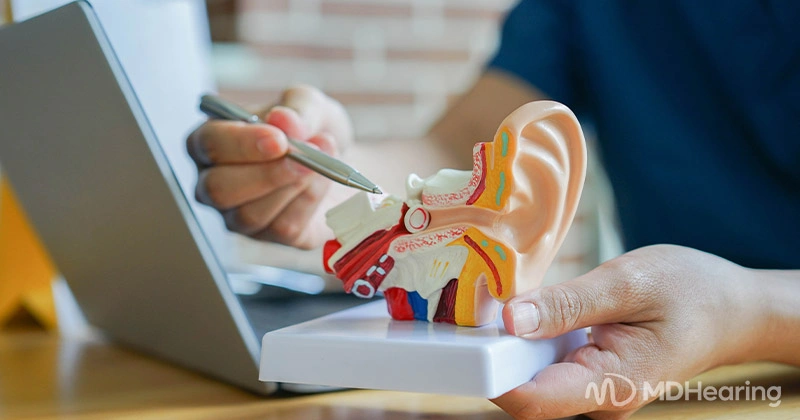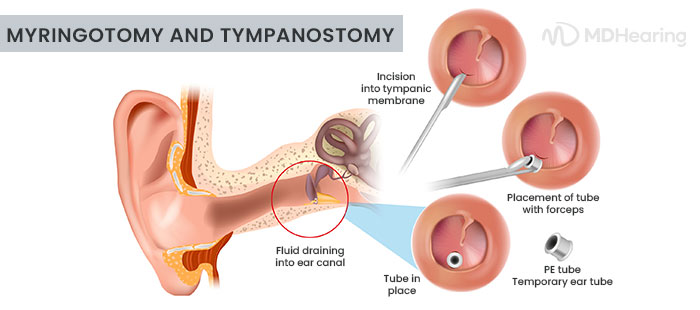Ear tubes for children are common. It’s possible your own child has benefited from ear tubes. But did you know that adults sometimes need ear tubes as well?
This article explains everything about ear tubes, including what they are, why surgery is needed, who can benefit from them, and what to expect before and after surgery.
What Are Ear Tubes?
Your body naturally has its own set of ear tubes called the Eustachian tube. This long tube connects the middle ear space (behind the eardrum) to the top of the throat.
The Eustachian tube is filled with air that flows into the middle ear, which is vital for pressure regulation and fluid drainage. For example, your ears may “pop” during take-off or landing while in an airplane. When the altitude changes too fast, the Eustachian tube can’t react right away. Chewing gum or yawning helps equalize the pressure in the middle ear so that it matches the pressure outside of the body.
In addition, the Eustachian tube drains fluid out of the middle ear to keep it from building up. When you get a cold, for instance, the Eustachian tube helps prevent bacteria and other germs from getting in the middle ear and causing an infection.
Artificial tubes that are surgically inserted into the eardrum are known as tympanostomy tubes. You may also hear them called myringotomy tubes, ventilation tubes, and pressure equalization tubes. They’re metal or plastic hollow cylinders designed to assist when the Eustachian is no longer working or not able to work efficiently, like in small children.
Why Ear Tube Surgery Is Done
When you get a cold or infection, the Eustachian tube can become blocked, preventing air from passing through. This is why you get a stuffy nose and ears or ear pain and pressure. In some cases, it may be hard for you to hear, and your ears may ring (tinnitus).
When the Eustachian tube doesn’t function properly, fluid and pressure can build up in the middle ear. This can be caused by many factors and lead to a wide range of ear-related problems.
ENTs commonly perform ear tube surgery to treat the following medical conditions:
- Acute otitis media (chronic ear infections)
- Balance problems
- Hearing loss (caused by a middle ear infection)
- Barotrauma (ear pain due to air pressure changes caused by a blocked Eustachian tube)
- Abnormal shape of ears or mouth
- Other rare conditions (e.g., Down Syndrome, cleft palate) where the Eustachian tube does not function properly
An ear tube works by balancing the pressure in your ear. This helps prevent ear infections and other issues caused by fluid buildup (effusion).
Difference Between a Myringotomy and Tympanostomy
There are two types of surgical procedures your otolaryngologist—or ENT (ear, nose, and throat doctor)—may perform: myringotomy and tympanostomy.
Myringotomy
Myringotomy is a surgical procedure that involves cutting a tiny hole in the ear drum. The surgeon drains excess fluid from the middle ear through the hole. Myringotomy is the primary treatment for chronic ear infections. It may or may not require the insertion of an ear tube.
Tympanostomy
Tympanostomy is the actual procedure for surgically placing a tube into the eardrum. Once the surgeon cuts a hole in the eardrum, they insert the ear tube. The ear tube continuously drains fluid from the middle ear and eventually falls out on its own.
The two are similar procedures in that they both involve surgery in the eardrum. However, their use depends on clinical indicators for myringotomy and tympanostomy tubes, which are based on an individual’s medical history, exams, and tests. Some people get relief solely from a myringotomy. Others require the addition of an ear tube.
Are Ear Tubes Only for Children?
Most people think of ear tubes as a treatment only designed for young children. It’s one of the most common types of surgeries children receive. In fact, nearly 9% of children had ear tube surgery as of 2014. You may be surprised to learn that adults sometimes also need ear tubes.
The reason children have ear tube surgery is primarily to treat ear infections. That’s because the Eustachian tube in young people is more horizontal than vertical, which makes it difficult to drain fluid from the middle ear space. Children are also more likely to get ear infections that don’t go away or keep coming back even when treated with antibiotics. If left untreated, an infection can lead to hearing loss, speech delays, poor performance in school, and other issues. Ear tubes help drain fluid from the middle ear, preventing infections from recurring.
Adults may experience frequent ear infections that require ear tubes. However, the most common reason adults get ear tubes is barotrauma. Ear tubes allow air into the middle ear, which helps relieve pressure.
Whether a child, teen, or adult, ear tubes can be necessary to maintain hearing health. The procedure itself is routine, with minimal downtime and recovery.
What to Expect During Ear Tube Surgery
The entire process of ear tube surgery takes less than 15 minutes. Many patients can return to work or school after a couple of days.
Before Ear Tube Surgery
Before surgery, your doctor may examine your ears, run hearing tests, and perform tympanometry. A tympanometer is a tool that measures how your eardrum responds to changes in pressure from sound waves.
If you can benefit from ear tubes, your doctor will set up your appointment for surgery. You’ll be instructed not to eat or drink after midnight the day before surgery to ensure you have an empty stomach. It’s also usually required to have a friend or family member available to drive you home.
During Ear Tube Surgery
Ear tube surgery in children is done under general anesthesia so that they’re put to sleep. Adults usually have tubes placed with a local anesthetic for ear infections. The surgeon starts by using a small microscope to view the inside of the ear. After cutting a hole in the eardrum, they suction out the excess fluid in the middle ear and insert the ear tube. The incision heals by itself, so there’s no need for stitches. When finished, your ear will be packed with gauze to catch the initial drainage.
After Ear Tube Surgery
Initially, it might feel like your ear is clogged. This is normal and should improve over the next few days. You can treat mild pain or discomfort with over-the-counter medications such as Tylenol. Some patients also receive numbing ear drops to help relieve the pain.
Following the doctor’s orders is essential to ensure a quick and successful recovery. This may include taking all medications as directed, changing gauze regularly, and wearing earplugs in the bath or shower. Surgery always poses a risk, so you should contact a medical professional if you notice anything unusual (e.g., ear pain, ear bleeding, fever, tube falls out right away or too soon, etc.)
If there are no complications following ear tube surgery, you can expect to be completely healed within about four weeks. Ear tubes typically fall out within 6–12 months after being inserted into the eardrum. Any ear infections you get will likely be less frequent and much milder. At the same time, ear tubes aren’t a cure for the infection, so they may need to be reinserted multiple times.
Get Your Hearing Tested
Ear tubes aren’t just for kids, even though it’s one of the most common types of childhood surgery. Many adults have recurring ear infections too, but most get ear tubes to treat painful barotrauma. Without treatment, you could risk chronic pain, permanent hearing loss, and other issues. Children could experience delayed speech and problems at school. Whatever the case, ear tubes work to drain fluids and equalize pressure in the middle ear.
If you have trouble hearing, consider taking our free online hearing test. At MDHearing, we offer high-quality, FDA-registered medical devices at affordable prices. You never have to worry about paying thousands of dollars—our hearing aids are available for only $299 per pair!
Check your hearing for free with this 5-minute test and see how we can help.
TAKE ONLINE HEARING TEST

